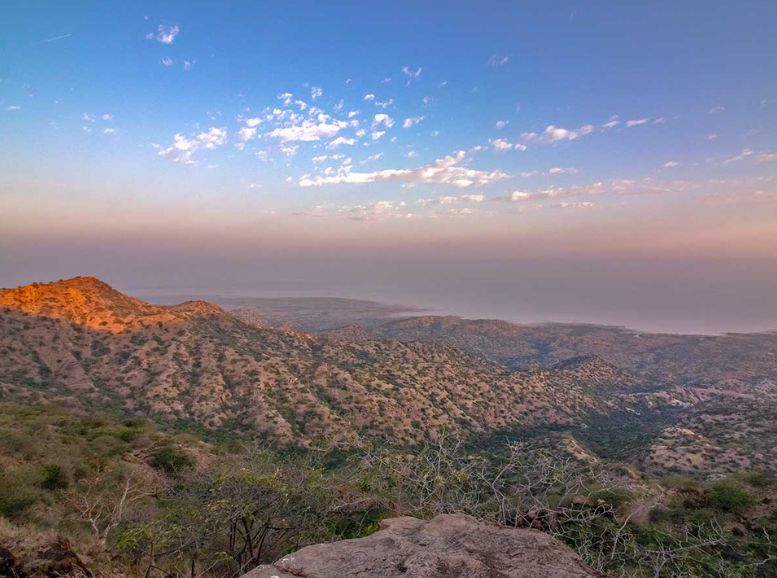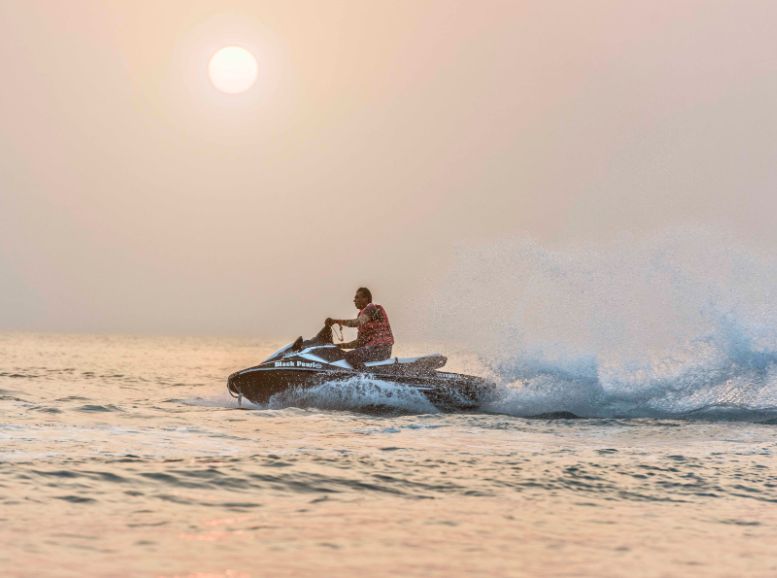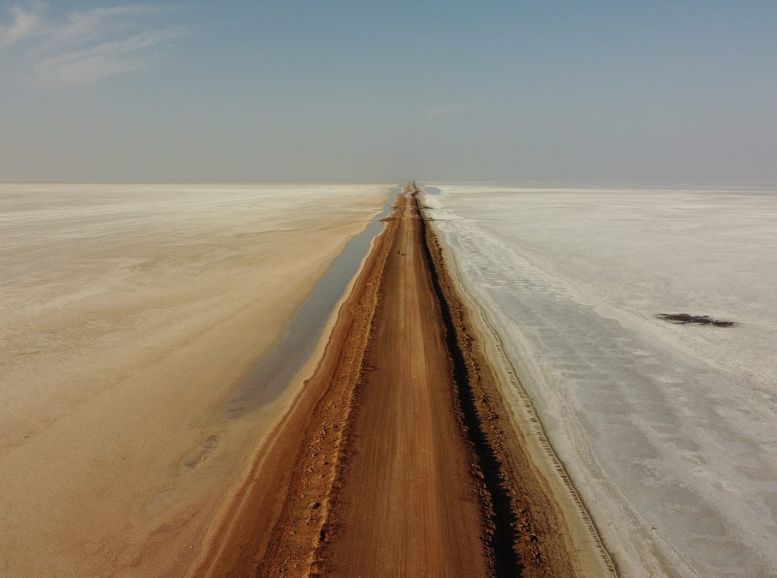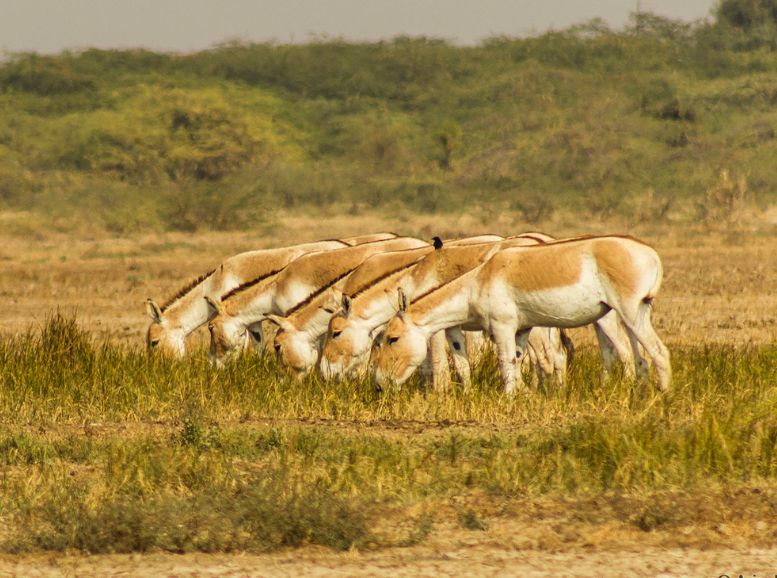In the remotest reaches of western India, where the desert meets the setting sun, lies the enchanting Kutch Desert of Gujarat. This land is a mesmerizing paradox, a canvas splashed with both the stark beauty of white and the riotous colors of a vibrant culture. The Rann of Kutch, a vast expanse of salt desert shimmering like a mirage, stands in dramatic contrast to the kaleidoscope of colors that adorn the villages. Here, ancient traditions are kept alive with fervor, and the warmth of the people matches the endless embrace of the desert itself. Each year, the call of Kutch’s untamed beauty and the legendary hospitality of its inhabitants beckons travelers from across the globe.
Are you an adventurer with a yearning to explore the unknown? Embark on a heart-pounding desert safari and feel the thrill course through your veins. Perhaps you’re a cultural enthusiast, captivated by the stories whispered in intricate crafts and the infectious energy of local festivals.
How to reach:
Soaring In:
Bhuj Airport (BHJ) is your key to arriving by air. This well-connected hub offers regular flights from major cities like Mumbai, Delhi, and Ahmedabad. Once you touch down, taxis and buses are on hand to transport you to your specific destination within Kutch.
Train Journey:
Bhuj Railway Station serves as the central train station for the Kutch Desert. Conveniently, trains from prominent cities like Mumbai, Delhi, and Ahmedabad arrive here. Popular options include the Bhuj Express (Mumbai), the Kutch Express (Mumbai and Ahmedabad), and the Sayajinagari Express (Ahmedabad). Upon arrival, local transportation like taxis, auto-rickshaws, and buses will take you to your chosen spot within the desert.
Road Trip Adventure:
- Ahmedabad to Bhuj: This roughly 330-kilometer journey takes about 7-8 hours by car. Take NH47 for a smooth ride.
- Mumbai to Bhuj: The distance between Mumbai and Bhuj is more significant, around 860 kilometers. Expect a travel time of 15-16 hours. The typical route involves NH48, with a switch to NH27 near Samakhiali.
- Rajkot to Bhuj: Travelers coming from Rajkot can reach Bhuj in about 5-6 hours, covering roughly 230 kilometers via NH27.
Best time to visit:
Winter Wonderland (November to February):
Winter reigns supreme as the most popular time to visit. Pleasant temperatures, ranging from 12°C to 25°C, make exploration a delight. This season boasts the Rann Utsav, a vibrant cultural extravaganza showcasing Kutch’s rich heritage through folk performances, music, exquisite handicrafts, and mouthwatering local cuisine. Under the glow of a full moon, the white Rann takes on an ethereal quality, creating an unforgettable spectacle.
Summer Siesta (March to June):
Summer paints the desert in a fiery palette, with temperatures reaching a scorching 45°C. The intense heat makes this season less ideal for travel, limiting outdoor activities. However, for those who can brave the heat, the upside is a more tranquil exploration experience with fewer crowds. Museums, local markets, and strategically planned early morning or late evening outings become the focus.
Monsoon Magic (July to September):
The monsoon season ushers in moderate rainfall, bringing relief from the heat. Temperatures range from 25°C to 35°C. While rain can disrupt travel and temporarily render the Rann inaccessible due to waterlogging, the landscape explodes into a vibrant tapestry of green, offering a refreshingly unique perspective. This season is best suited for exploring local villages and indoor attractions, as outdoor activities might be limited.
Attractions:
Kalo Dungar (Black Hill):

Crowned the “Black Hill,” Kalo Dungar reigns supreme as the highest point in Kutch, towering 462 meters above the desert floor. This vantage point unlocks a breathtaking panorama – the endless expanse of the Great Rann of Kutch, a shimmering sea of salt, stretching out to meet the rugged beauty of the arid plains. But Kalo Dungar offers more than just a scenic vista; it’s a place woven with spiritual threads.
Mandvi Beach:

Bhuj, a city steeped in history and vibrant culture, serves as your grand entrance to the captivating Kutch Desert. As the historical crown jewel of the region, Bhuj boasts architectural marvels that stand as testaments to its illustrious past.
Prepare to be dazzled by the Aina Mahal, also known as the “Palace of Mirrors.” This 18th-century architectural gem stuns visitors with its intricate and awe-inspiring mirror work. Ornate furnishings and captivating paintings further enrich the experience, transporting you back to a bygone era.
Dholavira:

Bhuj, a city humming with history and vibrant culture, serves as your grand entrance to the captivating Kutch Desert. As the undisputed crown jewel of the region, Bhuj boasts architectural marvels that whisper tales of its illustrious past.
Your Kutch adventure commences at the Aina Mahal, or the “Palace of Mirrors.” This 18th-century architectural wonder is a sight guaranteed to leave you spellbound. Imagine intricate mirror work reflecting endlessly, creating a mesmerizing kaleidoscope. Ornate furnishings and captivating paintings embellish the walls, transporting you to a bygone era of grandeur and artistry. Stepping into the Aina Mahal is like stepping back in time, offering a glimpse into the heart of Bhuj’s rich heritage.
Wild Ass Sanctuary, Kutch Desert:

Deep within the Little Rann of Kutch lies the Wild Ass Sanctuary, a realm dedicated to safeguarding the magnificent Indian wild ass, or ghudkhur, from the clutches of endangerment. This sprawling sanctuary, stretching over 5,000 square kilometers, is a tapestry woven from diverse ecosystems. Here, saline deserts seamlessly blend into wetlands and arid grasslands, creating a haven for a remarkable variety of wildlife.
The star attraction, undoubtedly, is the majestic wild ass. But the sanctuary offers much more. Keep your eyes peeled for the imposing nilgai (blue bull) with its impressive horns, the graceful chinkara (Indian gazelle) flitting across the plains, and a dazzling array of birds. From the flamboyant flamingo to the majestic pelican, the skies come alive with both resident and migratory birds, adding a symphony of color to the landscape.
Local Experiences:
- Become an Artisan: Learn age-old crafts like embroidery, pottery, and block printing from local artisans in villages like Hodka or the Kala Raksha Center.
- Festival Extravaganza: Witness the Rann Utsav (November to February), a vibrant spectacle showcasing Kutch’s rich heritage through folk dances, music, local delicacies, and exquisite crafts.
- Live Under the Stars: Experience a unique stay in a traditional mud hut (bungha) adorned with intricate designs and mirror work, particularly in Hodka village.
- A Cultural Feast: Immerse yourself in the rhythm of Kutch with live folk music and dance performances, especially during local festivals and events.
- Wild Ass Encounter: Embark on a jeep safari in the Wild Ass Sanctuary to spot the endangered Indian wild ass alongside other wildlife like nilgai, chinkara, and a variety of birds.
- A Birder’s Paradise: Observe a kaleidoscope of migratory birds, including flamingos and pelicans, in the wetlands of the Little Rann of Kutch and other sanctuaries.
- Sunset Symphony: Ascend Kalo Dungar (Black Hill) for breathtaking panoramic views and witness the sky erupt in a fiery spectacle as the sun dips below the horizon, casting its glow over the vast expanse of the Great Rann of Kutch.
- Echoes of the Indus Valley: Explore Dholavira, an ancient Indus Valley Civilization site boasting well-preserved ruins and an archaeological museum showcasing artifacts.
- A Journey Through Time: Discover Bhuj’s architectural marvels like the Aina Mahal (Palace of Mirrors), Prag Mahal, and the Bhujia Hill Fort.
- A Royal Retreat: Take a tour of Vijay Vilas Palace near Mandvi Beach, marveling at its unique Indo-European architecture and lush gardens.
- A Sacred Sanctuary: Visit the serene Narayan Sarovar Lake and nearby temples, combining a spiritual experience with a chance to explore wildlife and nature.
- Hilltop Tranquility: Experience the spiritual ambiance of the Dattatreya Temple atop Kalo Dungar and learn about the fascinating legend of the divine feeding of jackals.
- Desert Explorations: Embark on a thrilling camel or jeep safari across the vast white salt flats and stark landscapes of the Rann of Kutch.
- Beachside Bliss: Relax on the scenic Mandvi Beach and indulge in activities like camel rides, ATV adventures, and water sports.
Travel tips:
What to Pack:
- Light cotton clothes: Ideal for the warm daytime temperatures.
- Warm layers: Pack sweaters or jackets for the cooler evenings and nights, especially during winter.
- Comfortable walking shoes: Essential for navigating the diverse terrain, from desert sands to village paths.
Reaching Kutch:
- By Air: Bhuj Airport (BHJ) is the nearest domestic airport, with regular flights from major cities like Mumbai and Ahmedabad.
- By Train: Bhuj Railway Station is the main station, well-connected to major cities via express trains.
- Local Transport: Taxis, auto-rickshaws, or rented cars are convenient for local travel within towns. For exploring remote areas, consider hiring a local guide who can navigate the terrain and offer cultural insights.
Finding Your Place to Stay:
- Advance Booking: Especially during the Rann Utsav (held from November to February), book your accommodation well in advance, as hotels and tents fill up quickly.
- Stay Options: Kutch offers a variety of unique stays. Choose from luxurious tents offering modern amenities amidst the desert landscape, heritage hotels steeped in history, or traditional mud huts (bhungas) in villages like Hodka for an authentic experience.
Health and Safety Tips:
- Hydration: Stay hydrated by drinking plenty of water throughout the day, especially during the hot summer months.
- Food Safety: Opt for cooked meals at reputable restaurants. Avoid street food that might not be hygienically prepared.
- Travel Insurance: Consider getting travel insurance to cover any unexpected medical emergencies or trip cancellations.
Cultural Sensitivity:
- Respect Traditions: Dress modestly, especially in rural areas and religious sites. Be mindful of local customs and traditions.
- Photography Etiquette: Always seek permission before photographing people or their property.
Staying Connected and Managing Money:
- Cash: Carry enough cash, as ATMs may be limited in remote areas. Major towns like Bhuj will have ATM facilities.
- Mobile Connectivity: Mobile networks are generally good in towns, but may be weak or unavailable in remote desert areas. Consider carrying a local SIM card for better connectivity.
Conclusion
Unveiling the magic of Gujarat’s Kutch Desert, a land where the surreal expanse of the Rann meets the vibrant festivities of the Rann Utsav. Explore ancient ruins like Dholavira, marvel at panoramic vistas from Kalo Dungar, and learn from traditional artisans in villages like Hodka. Soak in the serenity of Mandvi Beach, embark on a wildlife safari, or lose yourself in Bhuj’s bustling markets. Plan your unforgettable Kutch adventure with Xplro.com, our comprehensive travel guide that offers everything you need to know, from must-see attractions to sustainable travel practices. Craft the perfect itinerary and let Xplro.com guide you through the wonders of Kutch.
FAQs
1. What is the suggested time to visit the Kutch Desert?
- The optimal time to visit the Kutch Desert is during the winter months, from November to February, when the weather is pleasant, ideal for exploring the Kutch Desert desert and enjoying cultural festivals like the Rann Utsav.
2. What is the Rann Utsav, and when does it take place?
- The Rann Utsav is an annual cultural festival celebrated in the Kutch Desert, typically held from November to February. It showcases the region’s culture through folk music, dance performances, handicrafts, and traditional cuisine.
3. How do I get to the Kutch Desert?
- The nearest airport to the Kutch Desert is located in Bhuj. Bhuj also has a well-connected railway station linking major cities like Ahmedabad. From Bhuj, you can hire taxis or join organized tours to explore different parts of the desert.
4. What are the must-visit attractions in the Kutch Desert?
- Key attractions include the Great Rann of Kutch, Kalo Dungar (Black Hill), Dholavira (an Indus Valley Civilization site), Mandvi Beach, Bhuj’s historical sites (Aina Mahal, Prag Mahal), and the Wild Ass Sanctuary.
5. What activities can I enjoy in the Kutch Desert?
- Visitors can partake in camel safaris, jeep safaris in wildlife sanctuaries, cultural performances during the Rann Utsav, exploring ancient archaeological sites, shopping for local handicrafts, and relaxing at beaches like Mandvi.
6. What should I pack for a trip to the Kutch Desert?
- It’s advisable to pack lightweight cotton clothing, comfortable walking shoes, sunscreen, sunglasses, a hat, and warm layers for cooler evenings. Additionally, carry a basic medical kit with necessary medications.
7. Are there accommodations available in the Kutch Desert?
- Yes, accommodations range from luxury tents during the Rann Utsav to heritage hotels, guesthouses, and traditional mud huts (bhungas) found in villages like Hodka.
8. What are the dining options in the Kutch Desert?
- Dining options in the Kutch Desert include local Kutchi cuisine available at hotels, restaurants, and during the Rann Utsav. Popular dishes include Dabeli, Kutchi Dabeli, and traditional sweets like Gulab Pak and Adadiya Pak.
9. Is it safe to visit the Kutch Desert?
- Yes, the Kutch Desert is generally safe for tourists. However, it’s advisable to take standard precautions regarding personal safety, health, and to respect local customs and traditions.
10. What are some lesser-known attractions in the Kutch Desert?
- Lesser-known attractions include Narayan Sarovar Sanctuary, the Kala Raksha Center for traditional crafts, Hodka Village for rural experiences, and local markets in Bhuj for purchasing handicrafts in Kutch Desert.
11. Can I visit the Kutch Desert with children and elderly travelers?
- Yes, many parts of the Kutch Desert are accessible for visitors of all ages. However, consider the weather conditions and plan activities accordingly. Some attractions may involve moderate physical activity.
12. How can I contribute to sustainable tourism in the Kutch Desert?
- To support sustainable tourism, consider purchasing handmade crafts directly from local artisans, minimizing plastic usage, disposing of waste responsibly, respecting wildlife and natural habitats, and choosing eco-friendly accommodations when possible.





